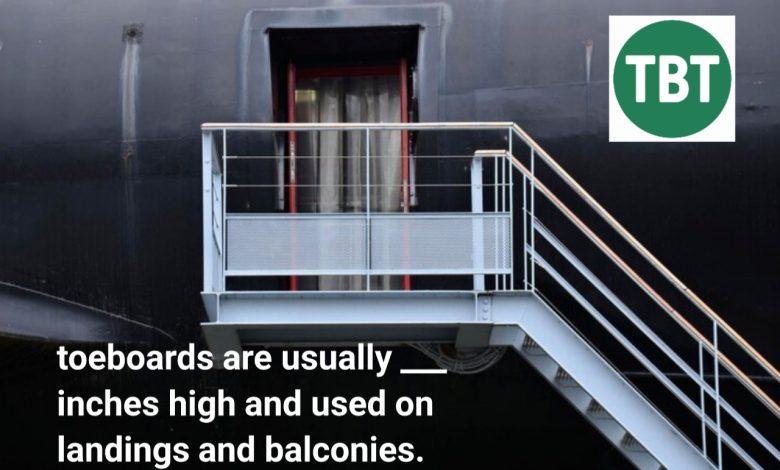toeboards are usually ___ inches high and used on landings and balconies.

Introduction
Toeboards are an essential safety feature in construction and industrial environments, particularly on elevated surfaces like landings and balconies. These low barriers play a critical role in preventing tools, debris, and materials from falling off working platforms, thus protecting workers and passersby from potential injuries. The standard height of a toeboard is typically 3.5 inches, but the safety benefits they provide far exceed their modest size. This article will explore everything you need to know about toeboards, including their purpose, materials, installation guidelines, compliance with safety standards, and best practices.
Understanding the Purpose of Toeboards
Toeboards are designed to prevent objects from falling off the edges of scaffolding, landings, balconies, and other elevated surfaces. In construction sites, tools, equipment, and materials often get knocked off accidentally, creating a risk of falling debris that could injure workers below.
Toeboards act as a physical barrier to prevent such accidents. They are typically placed at the edges of scaffolds, walkways, and elevated platforms to stop debris from rolling or falling over. The height of 3.5 inches is sufficient to stop small tools, materials, or debris from being accidentally kicked off or dropped from the working surface.
Furthermore, they serve to enhance the overall safety of the worksite by helping workers to remain focused on their tasks without worrying about falling objects. The use of toeboards is a fundamental part of a comprehensive fall prevention strategy and can significantly reduce the chances of injury related to dropped objects.
OSHA Standards for Toeboards
In the United States, the Occupational Safety and Health Administration (OSHA) mandates specific guidelines for the use of toeboards in construction and industrial settings. According to OSHA standards, toeboards must meet specific requirements to ensure they provide adequate protection.
The OSHA regulation 1910.29(k)(1)(ii) specifies that toeboards must have a minimum vertical height of 3.5 inches. This is the standard height required to effectively prevent objects from falling off an elevated surface. Toeboards must also have a gap of no more than 0.25 inches between the bottom of the toeboard and the surface it is installed on.
Additionally, OSHA requires that toeboards be strong enough to withstand a force of at least 50 pounds (222 N) applied in any direction. This ensures that they will remain in place even if external pressure is applied, preventing them from being dislodged or knocked over during the course of work.
By following OSHA’s guidelines, employers can ensure that their work sites meet safety standards and reduce the risk of falling debris injuries.
Materials Commonly Used for Toeboards
Toeboards can be made from a variety of materials, each offering specific benefits depending on the requirements of the construction site and the environment. Common materials used for toeboards include wood, metal, and plastic.
- Wood: Wood has historically been the most common material for toeboards. It is relatively inexpensive and easy to cut and install. However, wood can be prone to wear and tear over time, especially in outdoor or high-moisture environments, which may require periodic maintenance or replacement.
- Metal: Metal toeboards, such as those made from steel or aluminum, offer superior strength and durability. They are often used in heavy-duty applications where extra strength is necessary. Metal toeboards are more resistant to environmental factors like moisture, rust, and extreme temperatures, making them ideal for construction sites with demanding conditions.
- Plastic: Plastic toeboards are lightweight, corrosion-resistant, and easy to handle, making them a good option for temporary or indoor settings. They are often used in smaller construction projects or environments where they are not exposed to harsh elements.
The choice of material for toeboards largely depends on factors such as cost, durability, and the specific environment in which they are used. Employers should consider these factors carefully when choosing toeboards for their worksite.
Installation Guidelines for Toeboards
To ensure that toeboards function effectively, proper installation is crucial. If not installed correctly, toeboards may fail to provide the intended protection, exposing workers to potential hazards. Here are key considerations when installing toeboards:
- Positioning: Toeboards should be installed along the edges of elevated surfaces such as scaffolds, landings, and balconies. They should run the entire length of the edge, ensuring that there are no gaps or spaces where objects could fall through.
- Height Compliance: It is essential that toeboards meet the minimum height of 3.5 inches, as outlined in OSHA regulations. This ensures that the toeboard provides adequate protection against falling objects.
- Strength and Stability: Toeboards should be securely fastened to prevent them from becoming dislodged during use. They must be capable of withstanding the specified force of 50 pounds in any direction. Regular checks should be conducted to ensure the toeboard remains secure throughout the duration of the project.
- Maintenance: Toeboards should be inspected regularly to ensure they are in good condition and still meet the height and strength requirements. Any damaged or worn-toeboards should be repaired or replaced immediately to maintain safety.
By following these guidelines, employers can ensure that their toeboards are installed correctly and function as intended, reducing the risk of accidents on the job site.
The Role of Toeboards in Fall Protection Systems
Toeboards play an essential role in the overall fall protection system on construction sites. While they are primarily designed to prevent falling objects, they also help to enhance the overall safety of workers by complementing other fall protection measures, such as guardrails.
- Complementing Guardrails: Guardrails are typically used to prevent personnel from falling off elevated surfaces, while toeboards prevent debris from falling. Together, these two safety measures provide comprehensive protection for workers, addressing both personal and object fall hazards.
- Enhanced Safety on Landings and Balconies: In areas where guardrails may not be feasible or where the risk of falling debris is particularly high, toeboards offer an additional layer of protection. This is especially important on landings and balconies where the combination of fall risk and the potential for dropped objects can pose a significant hazard to workers below.
While toeboards are not designed to prevent falls from personnel, their ability to prevent objects from falling off elevated surfaces makes them a crucial part of the overall fall protection strategy. When properly installed and maintained, toeboards help create a safer working environment.
Compliance with International Standards
Although OSHA standards are specific to the United States, other countries also have regulations regarding the use of toeboards. Internationally, there are similar guidelines in place to ensure the safety of workers and the proper use of toeboards.
- European Union: In the European Union, safety regulations regarding toeboards closely mirror those set by OSHA. Toeboards are required to meet specific height and strength standards to ensure the protection of workers from falling objects.
- Australia: Australia’s standards also emphasize the use of toeboards to prevent falling objects and maintain a safe work environment. Australian regulations align with international safety practices and stress the importance of using toeboards on elevated surfaces.
Employers should familiarize themselves with the specific regulations applicable in their respective countries or regions to ensure compliance and avoid potential penalties for non-compliance.
Best Practices for Maintaining Toeboards
Maintaining the integrity of toeboards is critical to ensuring that they continue to function as a protective barrier on elevated surfaces. Regular inspection and maintenance practices are necessary to ensure the long-term effectiveness of toeboards.
- Regular Inspections: Toeboards should be inspected frequently for signs of wear, damage, or degradation. Inspections should include checking the height of the toeboard, verifying that it is securely fastened, and ensuring that there are no gaps or cracks that could allow objects to fall.
- Prompt Repairs: If a toeboard is damaged or compromised in any way, it should be repaired or replaced immediately. Delaying repairs can lead to increased risk of falling objects and potential injuries on the job site.
- Training: Workers should be educated about the importance of toeboards and their role in preventing falling objects. Training should also include guidelines on how to properly install and maintain toeboards to ensure they remain effective throughout the duration of the project.
By adhering to these best practices, employers can ensure the continued safety of their work sites and minimize the risk of injuries caused by falling objects.
Read More: techbtimes.co.uk
Conclusion
Toeboards, typically 3.5 inches high, play a crucial role in preventing objects from falling off elevated surfaces like landings and balconies. These small barriers are an integral part of a broader fall protection strategy, helping to keep workers safe from falling debris. Compliance with OSHA regulations, proper installation, and ongoing maintenance are essential to ensuring that toeboards remain effective and reliable. By understanding the purpose, materials, installation guidelines, and best practices associated with toeboards, employers can create a safer work environment and reduce the risk of accidents on their construction sites.

